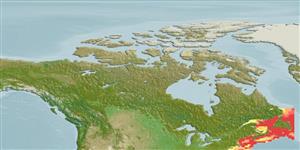Preferred temperature (Ref.
123201): 0.6 - 7.6, mean 4.1 °C (based on 186 cells).
Phylogenetic diversity index (Ref.
82804): PD
50 = 0.5625 [Uniqueness, from 0.5 = low to 2.0 = high].
Bayesian length-weight: a=0.00240 (0.00149 - 0.00387), b=3.19 (3.06 - 3.32), in cm total length, based on LWR estimates for this species & (Sub)family-body (Ref.
93245).
ຊັ້ນເຂດຮ້ອນ (Ref.
69278): 3.5 ±0.2 se; based on diet studies.
ຄວາມຢືດຢຸ່ນ (Ref.
120179): ຕຳ່, ປະຊາກອນຕຳ່ສຸດທີ່ໃຊ້ເວລາສອງເທົ່າ 4.5 - 14 ປີ (Fec assumed to be <100).
Prior r = 0.09, 95% CL = 0.06 - 0.13, Based on 1 full stock assessment.
Fishing Vulnerability (Ref.
59153): High vulnerability (58 of 100).
Nutrients (Ref.
124155): Calcium = 9.5 [1.4, 50.2] mg/100g; Iron = 0.337 [0.071, 1.045] mg/100g; Protein = 16.7 [13.9, 19.3] %; Omega3 = 0.613 [0.180, 2.396] g/100g; Selenium = 11.7 [2.8, 39.2] μg/100g; VitaminA = 9.68 [2.07, 45.52] μg/100g; Zinc = 0.452 [0.222, 0.862] mg/100g (wet weight);
